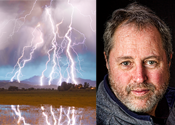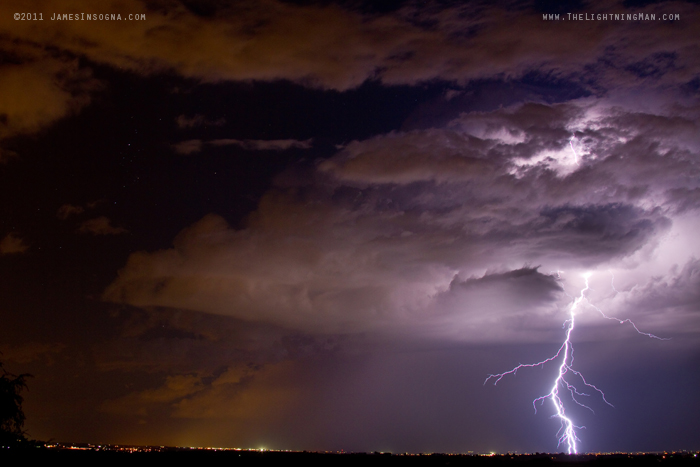Cloud-to-ground lightning
A lightning bolt starting high up in the cumulonimbus clouds working is way down to striking the ground. Giant cloud to ground C2G lightning bolt hitting the horizon of city lights. NE Boulder County Colorado. August 20th, 2011, 11:00Pm. Striking fine art nature lightning landscape photography prints, stock images and canvas art .
This is the best known and second most common type of lightning. Of all the different types of lightning, it poses the greatest threat to life and property since it strikes the ground. Cloud-to-ground lightning is a lightning discharge between a cumulonimbus cloud and the ground. It is initiated by a leader stroke moving down from the cloud.
Multiple paths of cloud-to-cloud Lightning discharges may occur between areas of cloud without contacting the ground. When it occurs between two separate clouds it is known as inter-cloud lightning and when it occurs between areas of differing electric potential within a single cloud, it is known as intra-cloud lightning. Intra-cloud lightning is the most frequently occurring type.
These are most common between the upper anvil portion and lower reaches of a given thunderstorm. This lightning can sometimes be observed at great distances at night as so-called “heat lightning”. In such instances, the observer may see only a flash of light without hearing any thunder. The “heat” portion of the term is a folk association between locally experienced warmth and the distant lightning flashes.
Another terminology used for cloud-cloud or cloud-cloud-ground lightning is “Anvil Crawler”, due to the habit of the charge typically originating from beneath or within the anvil and scrambling through the upper cloud layers of a thunderstorm, normally generating multiple branch strokes which are dramatic to witness. These are usually seen as a thunderstorm passes over the observer or begins to decay. The most vivid crawler behavior occurs in well developed thunderstorms that feature extensive rear anvil shearing.
Lightning Fact: Lightning kills more people on an annual basis than tornadoes, hurricanes or winter storms. It is second only to flash floods in the annual number of deaths caused by storm-related hazards.
Lightning Fact: Damage costs from lightning are estimated at $4-5 billion each year in the U.S.
Recent Post:
Cloud to Ground Lightning Strike Black and White Portrait
Double Trouble Lightning Strikes
Lightning Bolts Hitting the CO Continental Divide Crop
Lightning Bolts Striking the CO Front Range Foothills
A Lightning Photography Photographers Storm Chaser Log
Lightning Striking Weld County Looking East from County Line CO
Colorful CO Cloud to Cloud Lightning Photography
July 13th Colorado Rocky Mountain Front Range Lightning Thunderstorms
St Vrain Tree Lightning Storm July 12 2011
Lightning Thunderstorm Images Video 2011
Fire Rescue Station 67 Colorado Lightning Thunderstorm with USA Flag
Last Day of June Lightning Photography Thunderstorm Chase
Lightning Bolts Striking in Loveland Colorado
County Line Northern Colorado Lightning Storm Panorama
County Line 1 Northern Colorado Lightning Storm
Lightning Strikes Boulder and North Boulder County Colorado






[…] Lightning Bolts Starting High and Working Low […]
[…] Lightning Bolts Starting High and Working Low […]
[…] Lightning Bolts Starting High and Working Low […]